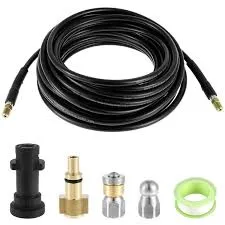air conditioner hose pipe
Understanding Air Conditioner Hose Pipes Importance and Functionality
Air conditioning units are an essential part of modern life, providing comfort and relief during hot weather. Among the many components that make up an air conditioning system, the hose pipe plays a crucial role. Understanding the function and importance of air conditioner hose pipes can contribute to proper maintenance and ensure optimal performance of the cooling system.
What is an Air Conditioner Hose Pipe?
An air conditioner hose pipe is a flexible tube that facilitates the passage of refrigerant, which is essential for the cooling process in air conditioning systems. Depending on the type of air conditioning unit—be it central, window, or portable—the configuration and size of the hose pipes can vary. In most cases, these pipes are made from durable materials that can withstand the high pressures and temperatures associated with refrigerant flow.
Functionality of Hose Pipes
The primary function of the hose pipe in an air conditioning system is to transport refrigerant between the evaporator and the condenser. In the refrigeration cycle, the refrigerant absorbs heat from the indoor air in the evaporator coil and then moves to the condenser coil outside, where it releases the absorbed heat to the atmosphere. This cycle continues, creating a cooling effect indoors.
Hose pipes also help in drainage. In many air conditioning systems, especially window and portable units, condensed moisture needs to be directed away from the unit to prevent water accumulation that could lead to mold and mildew growth. Hose pipes assist in transporting this condensation safely away from the air conditioning unit.
Types of Hose Pipes
1. Refrigerant Hose Pipes These are specifically designed to handle high pressure and are usually insulated to prevent heat transfer. They are often made of rubber or reinforced materials to ensure flexibility and durability.
air conditioner hose pipe

2. Drain Hose Pipes These lighter and more flexible hoses are used to direct condensate away from the unit. They are typically made of PVC or silicone and are designed to resist clogging.
3. Discharge Hose Pipes Used in high-capacity air conditioning systems, these hoses transport refrigerant from the compressor to the condenser. They handle high-pressure refrigerant, thus requiring robust construction.
Importance of Proper Maintenance
Regular maintenance of air conditioner hose pipes is vital for several reasons
- Efficiency Leaks in the hose can lead to refrigerant loss, reducing the cooling efficiency of the system. Ensuring the integrity of the hoses can help maintain optimal performance.
- Prevention of Breakdowns Old or damaged hose pipes can lead to system failures, costly repairs, or even complete replacement of the unit. Regular inspections can catch issues early.
- Safety Refrigerants can be hazardous. Damaged hoses can lead to leaks, which can pose health risks if inhaled. Keeping hose pipes in good condition can prevent such dangers.
Conclusion
In summary, air conditioner hose pipes are integral components of any air conditioning system, facilitating the essential processes of refrigerant flow and drainage. By understanding their functionality and importance, homeowners and maintenance professionals can ensure that air conditioning units operate efficiently and safely. Regular maintenance of these hoses is critical, as it not only extends the lifespan of the air conditioning system but also helps in maintaining a comfortable indoor environment. As we continue to rely on air conditioning for comfort during scorching summer months, paying attention to every detail, including the hose pipes, can make a significant difference in overall performance and safety.
-
Ultimate Spiral Protection for Hoses & CablesNewsJun.26,2025
-
The Ultimate Quick-Connect Solutions for Every NeedNewsJun.26,2025
-
SAE J1401 Brake Hose: Reliable Choice for Safe BrakingNewsJun.26,2025
-
Reliable J2064 A/C Hoses for Real-World Cooling NeedsNewsJun.26,2025
-
Heavy-Duty Sewer Jetting Hoses Built to LastNewsJun.26,2025
-
Fix Power Steering Tube Leaks Fast – Durable & Affordable SolutionNewsJun.26,2025

